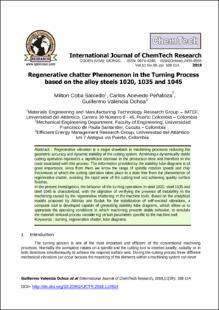| dc.contributor.author | Coba Salcedo, Milton Fabian | |
| dc.contributor.author | Acevedo Peñaloza, Carlos Humberto | |
| dc.contributor.author | Valencia Ochoa, Guillermo | |
| dc.date.accessioned | 2021-12-09T18:42:42Z | |
| dc.date.available | 2021-12-09T18:42:42Z | |
| dc.date.issued | 2018 | |
| dc.identifier.uri | http://repositorio.ufps.edu.co/handle/ufps/1772 | |
| dc.description.abstract | Regenerative vibration is a major drawback in machining processes reducing the
geometric accuracy and dynamic stability of the cutting system. Achieving a dynamically stable
cutting operation represents a significant decrease in the production time and therefore in the
costs associated with this process. The information provided by the stability lobe diagrams is of
great importance, since from them we know the range of spindle rotation speeds and chip
thicknesses at which the cutting operation takes place in a state free from the phenomenon of
regenerative chatter, avoiding the rapid wear of the cutting tool and achieving quality surface
finishes.
In the present investigation, the behavior of the turning operations in steel 1020, steel 1035 and
steel 1045 is characterized, with the objective of verifying the presence of instability in the
machining caused by the regenerative chattering in the machine tools. Based on the analytical
models proposed by Altintas and Budak for the stabilization of self-excited vibrations, a
computer tool is developed capable of generating stability lobe diagrams, which allow us to
appreciate the operating conditions in which machining presents stable behavior, to simulate
the material removal process considering certain parameters specific to the machine tool. | eng |
| dc.format.extent | 07 páginas | spa |
| dc.format.mimetype | application/pdf | spa |
| dc.language.iso | eng | spa |
| dc.publisher | International Journal of ChemTech Research | spa |
| dc.relation.ispartof | International Journal of ChemTech Research | |
| dc.rights | All Privacy & Copyrights reserved with Sai Scientific Communications. | eng |
| dc.source | https://sphinxsai.com/2018/ch_vol11_no9/ch01.htm | spa |
| dc.title | Regenerative chatter Phenomenon in the Turning Process based on the alloy steels 1020, 1035 and 1045 | eng |
| dc.type | Artículo de revista | spa |
| dcterms.references | Nwoke O, Okonkwo U, Okafor C, Imhade O. Evaluation of chatter vibration frequency in CNC turninf of 4340 alloy steel material. 2017, (July). | spa |
| dcterms.references | Dassanayake A V., Suh CS. On nonlinear cutting response and tool chatter in turning operation. Communications in Nonlinear Science and Numerical Simulation. 2008, 13 (5), pp.979–1001. | spa |
| dcterms.references | Altintas Y, Weck M. Chatter stability of metal cutting and grinding. CIRP Annals - Manufacturing Technology. 2004, 53 (2), pp.619–642. | spa |
| dcterms.references | Cardi AA, Firpi HA, Bement MT, Liang SY. Workpiece dynamic analysis and prediction during chatter of turning process. Mechanical Systems and Signal Processing. 2008, 22 (6), pp.1481–1494. | spa |
| dcterms.references | Yeh L-J, Lai G-J. A Study of the Monitoring and Suppression System for Turning Slender Workpieces. Proceedings of the Institution of Mechanical Engineers, Part B: Journal of Engineering Manufacture. 1995, 209 (3), pp.227–236. | spa |
| dcterms.references | Tian L, Wu J, Xiong Z, Ding H. Active Chatter Suppression in Turning of Low-Rigidity Workpiece by System Matching BT - Intelligent Robotics and Applications. In: Liu H, Kubota N, Zhu X, Dillmann | spa |
| dcterms.references | Lu K, Lian Z, Gu F, Liu H. Model-based chatter stability prediction and detection for the turning of a flexible workpiece. Mechanical Systems and Signal Processing. 2018, 100 , pp.814–826. | spa |
| dcterms.references | Da Silva MM, Venter GS, Varoto PS, Coelho RT. Experimental results on chatter reduction in turning through embedded piezoelectric material and passive shunt circuits. Mechatronics. 2015, 29 , pp.78–85. | spa |
| dcterms.references | Altintas Y. Manufacturing Automation: Metal Cutting Mechanics, Machine Tool Vibrations, and CNC Design. Cambridge University Press, 2012. | spa |
| dcterms.references | Sadiku MN, Alexander CK. Fundamentos de circuitos eléctricos. 5th ed. México D.F.: McGraw-Hill, 2013. | spa |
| dc.identifier.doi | http://dx.doi.org/10.20902/IJCTR.2018.110914 | |
| dc.publisher.place | India | spa |
| dc.relation.citationedition | Vol.11 No.9.(2018) | spa |
| dc.relation.citationendpage | 114 | spa |
| dc.relation.citationissue | 9(2018) | spa |
| dc.relation.citationstartpage | 108 | spa |
| dc.relation.citationvolume | 11 | spa |
| dc.relation.cites | Salcedo, M. C., Peñaloza, C. A., & Ochoa, G. V. Regenerative chatter Phenomenon in the Turning Process based on the alloy steels 1020, 1035 and 1045. | |
| dc.relation.ispartofjournal | International Journal of ChemTech Research | spa |
| dc.rights.accessrights | info:eu-repo/semantics/openAccess | spa |
| dc.rights.creativecommons | Atribución 4.0 Internacional (CC BY 4.0) | spa |
| dc.subject.proposal | turning | eng |
| dc.subject.proposal | regenerative chatter | eng |
| dc.subject.proposal | lobe diagram | eng |
| dc.type.coar | http://purl.org/coar/resource_type/c_6501 | spa |
| dc.type.content | Text | spa |
| dc.type.driver | info:eu-repo/semantics/article | spa |
| dc.type.redcol | http://purl.org/redcol/resource_type/ART | spa |
| oaire.accessrights | http://purl.org/coar/access_right/c_abf2 | spa |
| oaire.version | http://purl.org/coar/version/c_970fb48d4fbd8a85 | spa |
| dc.type.version | info:eu-repo/semantics/publishedVersion | spa |










